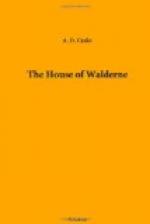THE HOUSE OF WALDERNE
A Tale of the Cloister and the Forest in the Days of the Barons’ Wars
by the Reverend A. D. Crake
Preface.
Prologue.
Chapter 1: The Knight And Squire.
Chapter 2: Michelham Priory.
Chapter 3: Kenilworth.
Chapter 4: In the Greenwood.
Chapter 5: Martin Leaves Kenilworth.
Chapter 6: At Walderne Castle.
Chapter 7: Martin’s First Day At Oxford.
Chapter 8: Hubert At Lewes Priory.
Chapter 9: The Other Side Of The Picture.
Chapter 10: Foul And Fair.
Chapter 11: The Early Franciscans.
Chapter 12: How Hubert Gained His Spurs.
Chapter 13: How Martin Gained His Desire.
Chapter 14: May Day In Lewes.
Chapter 15: The Crusader Sets Forth.
Chapter 16: Michelham Once More.
Chapter 17: The Castle Of Fievrault.
Chapter 18: The Retreat Of The Outlaws.
Chapter 19: The Preaching Friar.
Chapter 20: The Old Man Of The Mountain.
Chapter 21: To Arms! To Arms!
Chapter 22: A Medieval Tyrant.
Chapter 23: Saved As By Fire.
Chapter 24: Before The Battle.
Chapter 25: The Battle Of Lewes.
Chapter 26: After The Battle.
Epilogue.
Notes.
Preface.
It is not without pleasure that the author presents this, the twelfth of his series of historical novelettes, to his friends and readers; the characters, real and imaginary, are very dear to him; they have formed a part of his social circle for some two years past, and if no one else should believe in Sir Hubert of Walderne and Brother Martin, the author assuredly does. It was during a pleasant summer holiday that the plan of this little work was conceived: the author was taking temporary duty at Waldron in Sussex, during the absence of its vicar—the Walderne of our story, formerly so called, a lovely village situated on the southern slope of that range of low hills which extends from Hastings to Uckfield, and which formed the backbone of the Andredsweald. In the depths of a wood below the vicarage he found the almost forgotten site of the old Castle of Walderne, situate in a pathless thicket, and only approachable through the underwood. The moat was still there, although at that time destitute of water, the space within completely occupied by trees and bushes, where once all the bustle and life of a medieval household was centred.
The author felt a strong interest in the spot; he searched in the Sussex Archaeological Collections for all the facts he could gather together about this forgotten family: he found far more information than he had hoped to gain, especially in an article contributed by the Reverend John Ley, a former vicar of Waldron. He also made himself familiar with the topography of the neighbourhood, and prepared to make the old castle the chief scene of his next story, and to revivify the dry dust so far as he was able.




